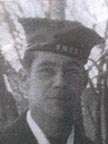
Our veterans
René Bertrand
Born on March 16, 1925, René, son of Élie O. Bertrand and Armandine Scott, joined the Navy at the age of 16 by falsifying his age by two years to be accepted.
He did his basic training in Montreal and then went to Signal School at Saint-Hyacinthe to learn the decoder trade. As his desire to become a sailor never left him, he soon headed for Halifax. There was no shortage of work at HMCS Cornwallis and Stadacona barracks and in the harbour, where René was always on the lookout for departing ships. He volunteered on the minesweeper HMCS Vegreville, which was heading to Reykjavik, Iceland. The presence of nearly 1,500 German submarines patrolling the North Atlantic made crossing that ocean extremely dangerous.
One expedition among others, remained engraved in the memory of René Bertrand. March 16, 1943, the day of his 18th birthday, he found himself in the thick of a fierce battle. Shortly after being transferred from the Royal Canadian Navy escort to the Royal Navy in the West Atlantic, convoys SC-122 (slow convoy) and HX-229 (fast convoy) were attacked by U-boats. The battle lasted three days, and twenty-one Canadian Merchant Marine ships were sunk. It should be noted that the Merchant Marine ships were unarmed. They depended on the ships and planes that escorted them for protection.
In 1944, René became a quartermaster on the crew bringing the new corvette, HMCS Belleville, from Kingston to Halifax.
Halifax Harbour was at the heart of military life. Military traffic was intense; food, ammunition, and troops were in constant movement between Europe and Canada. René boarded the troop carrier New Amsterdam to travel to Europe and take possession of the cruiser HMCS Ontario. This cruiser, with a crew of 1100, was the most modern cruiser in the British Empire. The young Canadian from L’Orignal experienced a proud moment in April 1945 when the Red Ensign was slowly raised on the mast of HMCS Ontario to the strains of our national anthem.
René Bertrand served in a few missions aboard the HMCS Ontario. First, he escorted a convoy to Murmansk, Russia, under constant threat from Luftwaffe aircraft flying above the convoy. The cruiser then headed to the Pacific and Japan. The journey was long: from the Mediterranean to Hong Kong via the Suez Canal, Aden, with a stop in Colombo and Trincomalee, Ceylon, (now Sri Lanka) to refuel. A few British generals then boarded HMCS Ontario to accept Japan’s unconditional surrender in Hong Kong.
Five hundred crewmembers disembarked to assist the Ghurkas, India’s military troops, and to ensure civilian prisoners’ release. The curfew was strict; after 6:30 p.m., no Chinese civilians were allowed on the streets, only members of the military. In Hong Kong, René Bertrand, (nicknamed Frenchie since his early days in the Navy), contracted malaria. Back on the ship, he recovered thanks to quinine and other medication.
The war being over, René Bertrand could finally return to Canada. It was a long and winding road from Manila in the Philippines, to Guam, then to Pearl Harbour where HMCS Ontario went from wartime grey to white, and then to Victoria, British Columbia. The last leg was by train to Montreal. René Bertrand returned home on Christmas Eve in 1945.
As a Veteran, René Bertrand was very active with the Hawkesbury Royal Canadian Legion. His excellent memory was a great asset to local researchers. In civilian life, his occupations were varied: owner of René Bertrand Petroleum, councillor for the Village of L’Orignal and mayor of the municipality. During his tenure as mayor, he had the L’Orignal Jail roof resurfaced with bright orange sheet metal. It was a legacy of sorts!
Mr. René Bertrand passed away on May 19, 2019, at the age of 94.
